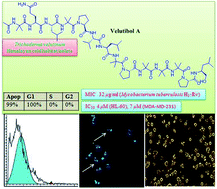14-Residue peptaibol velutibol A from Trichoderma velutinum: its structural and cytotoxic evaluation†
Abstract
Velutibol A (1), a new 14-residue peptaibol was isolated from the Himalayan cold habitat fungus Trichoderma velutinum. The structural characterization was carried out by 1D and 2D NMR studies, and tandem mass studies, and Marfey's method aided in determining the stereochemistry of the amino acids. The CD analysis revealed folding of the peptide in a 310-helical conformation. The intramolecular H-bonding was determined by an NMR-VT experiment. Cytotoxic evaluation was carried out against a panel of cancer cell lines. The cell cycle assay was carried out on human myeloid leukaemia (HL-60) cells and revealed the formation of apoptotic bodies and DNA damage in a dose-dependent manner. Three other peptaibols namely velutibol B (2), velutibol C (3), and velutibol D (4) were also isolated in trace amounts from the psychotropic fungus and characterized through tandem mass spectroscopy and Marfey's analysis.



 Please wait while we load your content...
Please wait while we load your content...